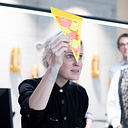Different listeners, listen differently
Active Listening is usually followed by ‘top tips’ and ‘eye contact’ is usually top of that list*.
Eye contact is great, it is something that can help active listening, but it’s not essential. Eye contact is also easier for neurotypical individuals.
Neurominorities as Beth Radulski Autistic Autism Researcher suggests may find keeping eye contact
- hard to understand. eg. the level of appropriateness
- distracting, as the energy going into maintaining eye contact
- distressing
and adds “Different listeners, listen differently” short, to the point, and a great one to remember. Think how you can take a human centred approach to active listening, wether you are the listener or the speaker. Do not demand eye contact (In fact let’s not demand anything in these circumstances) or things like ‘quiet hands’. Listen and be heard in a way that suits the persons needs
I mentioned “Quiet hands” is not a positive term it comes from ABA therapy, which was a practice of restraining autistic children’s hands. This must be incredibly distressing for the child and simply promotes masking.. Some neurodivergent folks people find that stimming, or self-stimulatory behaviours, can help them regulate their emotions which in turn can help to to lower distress. Think if you were feeling overstimulated or distressed from distorted perceptions, well the stimming many say can help by creating a soothing rhythm, it may not stop the stress but it can help calm it.
Again like they eye contact already mentioned, sitting still, like staring statues is encouraged in active listening, surely if people are fiddling and fidgeting they are not listening… heres the thing, they are.
My wonderful colleague Bobbu shared a presentation recently and explained from a neurodivergent perspective speaking of neurotypicals “Neurotypicals’s also rely on body language and eye contact to communicate nuances like emotional state, engagement with the conversation, etc.” Neurodiergent folks also use body language and eye contact, but sometimes in very different ways. These differences are often interpreted as negative
Expressions of excitement can be ‘too much’ or ‘too loud’.
Blank expressions when we are focusing hard can be interpreted as not engaging.
Fidgeting and self-stimulating can be interpreted as being distracted.
Lack of eye contact can be interpreted as a sign of deception.
Beth Radulski has written up some great research on communication and neurodiversity. As she says “For many NeuroMinorities, ‘listening’ means rocking, flapping, or fidgeting to focus. It means allowing the gaze to fall naturally rather than focusing on interpreting eye contact.”
I will finish where I started, with Beths quote, if you take only one thing away from this, I would love it to be the notion “Different listeners, listen differently”
Illustrations based on reading Beth Radulski , Specialisterne and Hat Talks among others. Links in comments to some of their writing
*This comes with an apology, as I feel in the past I have encouraged ‘eye contact’, even though it did not sit right with me, due to it being in these imaginary rules. Sorry, I am always learning.
https://neuroclastic.com/autistic-body-language/
https://stimpunks.org/eye-contact/#:~:text=Don%27t%20burden%20neurodivergent%20kids,make%20eye%20contact%20a%20goal.
https://us.specialisterne.com/focus-on-and-believe-your-autistic-employees-words-not-non-verbal-communication/
https://hattalks.uk
